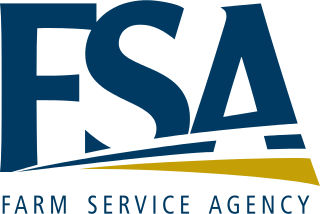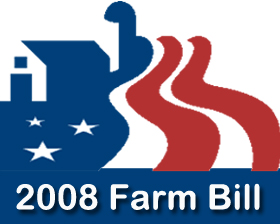Related Research Articles

An agricultural subsidy is a government incentive paid to agribusinesses, agricultural organizations and farms to supplement their income, manage the supply of agricultural commodities, and influence the cost and supply of such commodities.

The Farm Service Agency (FSA) is the United States Department of Agriculture agency that was formed by merging the farm loan portfolio and staff of the Farmers Home Administration (FmHA) and the Agricultural Stabilization and Conservation Service (ASCS). The Farm Service Agency implements agricultural policy, administers credit and loan programs, and manages conservation, commodity, disaster, and farm marketing programs through a national network of offices. The Administrator of FSA reports to the Under Secretary of Agriculture for Farm Production and Conservation. The current administrator is Zach Ducheneaux. The FSA of each state is led by a politically appointed State Executive Director (SED).
The Agricultural Marketing Service (AMS) is an agency of the United States Department of Agriculture; it maintains programs in five commodity areas: cotton and tobacco; dairy; fruit and vegetable; livestock and seed; and poultry. These programs provide testing, standardization, grading and market news services for those commodities, and oversee marketing agreements and orders, administer research and promotion programs, and purchase commodities for federal food programs. The AMS enforces certain federal laws such as the Perishable Agricultural Commodities Act and the Federal Seed Act. The AMS budget is $1.2 billion. It is headquartered in the Jamie L. Whitten Building in Washington, D.C.
The Commodity Credit Corporation (CCC) is a wholly owned United States government corporation that was created in 1933 to "stabilize, support, and protect farm income and prices". The CCC is authorized to buy, sell, lend, make payments, and engage in other activities for the purpose of increasing production, stabilizing prices, assuring adequate supplies, and facilitating the efficient marketing of agricultural commodities.

The Agricultural Adjustment Act of 1938 was legislation in the United States that was enacted as an alternative and replacement for the farm subsidy policies, in previous New Deal farm legislation, that had been found unconstitutional. The act revived the provisions in the previous Agriculture Adjustment Act, with the exception that the financing of the law's programs would be provided by the Federal Government and not a processor's tax, and was also enforced as a response to the success of the Soil Conservation and Domestic Allotment Act of 1936.

The Federal Agriculture Improvement and Reform Act of 1996, known informally as the Freedom to Farm Act, the FAIR Act, or the 1996 U.S. Farm Bill, was the omnibus 1996 farm bill that, among other provisions, revises and simplifies direct payment programs for crops and eliminates milk price supports through direct government purchases.

The Agricultural Act of 1954 is a United States federal law that, among other provisions, authorized a Commodity Credit Corporation reserve for foreign and domestic relief.

In the United States, the farm bill is a comprehensive omnibus bill that is the primary agricultural and food policy instrument of the federal government. Congress typically passes a new farm bill every five to six years.
The agricultural policy of the United States is composed primarily of the periodically renewed federal U.S. farm bills. The Farm Bills have a rich history which initially sought to provide income and price support to US farmers and prevent them from adverse global as well as local supply and demand shocks. This implied an elaborate subsidy program which supports domestic production by either direct payments or through price support measures. The former incentivizes farmers to grow certain crops which are eligible for such payments through environmentally conscientious practices of farming. The latter protects farmers from vagaries of price fluctuations by ensuring a minimum price and fulfilling their shortfalls in revenue upon a fall in price. Lately, there are other measures through which the government encourages crop insurance and pays part of the premium for such insurance against various unanticipated outcomes in agriculture.

The Agriculture and Food Act of 1981 was the 4-year omnibus farm bill that continued and modified commodity programs through 1985. It set specific target prices for 4 years, eliminated rice allotments and marketing quotas, lowered dairy supports, and made other changes affecting a wide range of USDA activities. The next year this farm bill was amended to freeze the dairy price support level and mandate loan rates and acreage reserve provisions for the 1983 crops. Again in 1984, amendments were adopted to freeze target prices, authorize paid land diversion for feed grains, upland cotton, and rice, and provide a wheat payment-in-kind program for 1984.
In the United States, Tobacco quotas were a supply control feature of federal price support for tobacco. Burley tobacco was subject to marketing quotas and flue-cured tobacco was subject to marketing quotas and acreage allotments. Tobacco quota owners voted every three years on whether or not to continue with price support and marketing quotas. Producers of several minor tobaccos had disapproved federal support. The national marketing quota was calculated according to a formula specified by law that included consideration of intended purchases by domestic manufacturers, average exports over the preceding three years, and reserve stock requirements. The effective quota was the basic quota plus and minus temporary adjustments for allowable previous year under and over marketings. The Fair and Equitable Tobacco Reform Act of 2004 ended tobacco quotas for 2005 crop and subsequent years.
The U.S. Sugar program is the federal commodity support program that maintains a minimum price for sugar, authorized by the 2002 farm bill to cover the 2002-2007 crops of sugar beets and sugarcane.
Under the marketing allotment provisions of the sugar program authorized by the 2002 farm bill, the Overall Allotment Quantity (OAQ) is the amount of domestically-produced sugar that processors of sugar cane and refiners of sugar beets can sell into the U.S. market during a fiscal year. The 2002 farm bill requires USDA to set the OAQ using the following formula:
No net cost is a requirement that certain commodity programs operate at no net cost to the federal government. The No Net Cost Tobacco Act of 1982 required an assessment on 1982 and subsequent tobacco crops to cover potential tobacco price support program losses. The 1985 farm bill required that USDA operate the sugar program for the first time at no cost; a provision repealed by the 1996 farm bill and reinstated by the 2002 farm bill. The 1996 changes to the peanut price support program were designed to ensure that it also operated at no cost. Subsequently, the peanut program was completely changed by the 2002 farm bill, but not in a manner to make it no-net-cost.
Poundage quotas were authorized by the Agricultural Adjustment Act of 1938, so the peanut poundage quota was the supply control mechanism for the peanut price support program until its revision in the 2002 farm bill.
The 2002 farm bill replaced the longtime (65-year) support program for peanuts with a framework identical in structure to the program for the so-called covered commodities. The three components of the Peanut Price Support Program are fixed direct payments, counter-cyclical payments, and marketing assistance loans or loan deficiency payments (LDPs). The peanut poundage quota and the two-tiered pricing features of the old program were repealed. Only historic peanut producers are eligible for the Direct and Counter-cyclical Program (DCP). All current production is eligible for marketing assistance loans and LDPs. Previous owners of peanut quota were compensated through a buy-out program at a rate of 55¢/lb. ($1,100/ton) over a 5-year period.
Marketing assessments are payments in United States agricultural policy. At times, producers and first purchasers of some supported commodities are required to pay assessments as a contribution towards achieving budget deficit reduction targets. Under the 1996 farm bill, assessments were imposed on sugar processors, producers, and first buyers of peanuts. However, the 1996 farm bill eliminated a milk marketing assessment. The 2002 farm bill eliminated the assessments for peanuts and sugar. Tobacco was subject to a no-net-cost assessment on all marketings to offset Commodity Credit Corporation (CCC) losses on price support loan operations until support was ended in 2005 under the quota buyout provision.

The United States Food and Agriculture Act of 1977 was an omnibus farm bill. The S. 275 legislation was passed by the 95th U.S. Congressional session and signed into law by the 39th President of the United States Jimmy Carter on September 29, 1977.
In United States agricultural policy, additional peanuts refers to peanuts sold from a farm in any marketing year in excess of the amount of quota peanuts sold from that farm. Additional peanuts must be exported or crushed into oil and meal. Additionals are eligible only for the lower of two price support levels available under the peanut price support program. The lower additionals loan rate is set to ensure that the Commodity Credit Corporation does not incur losses on their sale and disposal.
A farm's acreage allotment, under provisions of permanent commodity price support law, is its share, based on its previous production, of the national acreage needed to produce sufficient supplies of a particular crop. Under the 2002 farm bill, acreage allotments are not applicable to the covered commodities, peanuts, or sugar. Subsequently, allotments and quotas and price support for tobacco were eliminated beginning in 2005.
References
 This article incorporates public domain material from Jasper Womach. Report for Congress: Agriculture: A Glossary of Terms, Programs, and Laws, 2005 Edition (PDF). Congressional Research Service.
This article incorporates public domain material from Jasper Womach. Report for Congress: Agriculture: A Glossary of Terms, Programs, and Laws, 2005 Edition (PDF). Congressional Research Service.